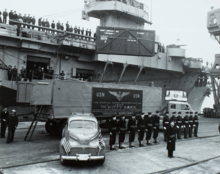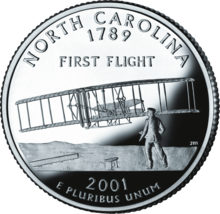Wright Flyer
[5] The Wright brothers flew it four times in a location now part of the town of Kill Devil Hills, about 4 miles (6 kilometers) south of Kitty Hawk, North Carolina.The airplane flew 852 ft (260 m) on its fourth and final flight, but was damaged on landing, and wrecked minutes later when powerful gusts blew it over.[6] In order to avoid the risk of torque effects from affecting the aircraft handling, one drive chain was crossed over so that the propellers rotated in opposite directions.As with the gliders, the pilot flew lying on his stomach on the lower wing with his head toward the front of the craft in an effort to reduce drag.The Wrights' pioneering use of "roll control" by twisting the wings to change wingtip angle in relation to the airstream led to the more practical use of ailerons by their imitators, such as Glenn Curtiss and Henri Farman.The numbers increased substantially over the subsequent years but during the war, all of the fighter aircraft flown by Americans were designed and built in Europe.[26] During flight tests near Dayton the Wrights added ballast to the nose of the aircraft to move the center of gravity forward and reduce pitch instability."[27] According to aviation author Harry Combs, "Wright designs incorporated a 'balanced' forward elevator...the movable surface extending an equal distance on both sides of its hinge or pivot axis, as opposed to an 'in-trail' configuration... which would have enhanced controllability in flight."They shipped the heavily damaged craft back to Dayton, where it remained stored in crates behind a Wright Company shed for nine years.The Smithsonian Institution, and primarily its then-secretary Charles Walcott, refused to give credit to the Wright Brothers for the first powered, controlled flight of an aircraft.[32] In 1925, Orville attempted to pressure the Smithsonian by warning that he would send the Flyer to the Science Museum in London if the Institution refused to recognize his and Wilbur's accomplishment.The threat did not achieve its intended effect, and on January 28, 1928, Orville shipped the Kitty Hawk to London for display at the museum.[33] It remained there in "the place of honour",[34] except during World War II when it was moved to an underground storage facility 100 miles (160 km) away, near Corsham.[32] In 1942, the Smithsonian Institution, under a new secretary, Charles Abbot, published a list of 35 Curtiss modifications to the Aerodrome and a retraction of its long-held claims for the craft.Abbot went on to list four regrets including the role the Institution played in supporting unsuccessful defendants in patent litigation by the Wrights, misinformation about modifications made to the Aerodrome after Wright Flyer's first flight, and public statements attributing the "first aeroplane capable of sustained free flight with a man" to Secretary Langley.[36][37]On October 18, 1948, the official handover of the Kitty Hawk was made to Livingston L. Satterthwaite, the American Civil Air Attaché[38] at a ceremony attended by representatives of the various flying organizations in the UK and by some British aviation pioneers such as Sir Alliott Verdon-Roe.McCurdy as a young man had been a member of Alexander Graham Bell's team Aerial Experiment Association, which included Glenn Curtiss, and later a famous pioneer pilot.[41] The Wright Flyer was put on display in the Arts and Industries Building of the Smithsonian on December 17, 1948, 45 years to the day after the aircraft's only successful flights.Since 2003 it has resided in a special exhibit in the museum titled "The Wright Brothers and the Invention of the Aerial Age," in recognition of the 100th anniversary of their first flight.The restoration was supervised by Senior Curator Robert Mikesh and assisted by Wright Brothers expert Tom Crouch.[42] In 1978, 23-year-old Ken Kellett built a replica Wright Flyer in Colorado and flew it at Kitty Hawk on the 75th and 80th anniversaries of the first flight there.The completed Flyer reproduction was brought to Kitty Hawk and pilot Kevin Kochersberger attempted to recreate the original flight at 10:35 on December 17, 2003, on level ground near the bottom of Kill Devil Hill.Numerous static display-only, nonflying reproductions are on display around the United States and across the world, making this perhaps the most reproduced single aircraft of the "pioneer" era in history, rivaling the number of copies – some of which are airworthy – of Louis Blériot's cross-Channel Bleriot XI from 1909.[46][47][48] This artifact is on display at the visitors center at the Wright Brothers National Memorial in Kitty Hawk, North Carolina.[49] In 1986, separate portions of original wood and fabric, as well as a note by Orville Wright, were taken by North Carolina native astronaut Michael Smith aboard the Space Shuttle Challenger on mission STS-51-L, which was destroyed soon after liftoff.The portions of wood and fabric and Wright's note were recovered from the wreck of the Shuttle and are on display at the North Carolina Museum of History.[50] A small piece of the Wright Flyer's wing fabric is attached to a cable underneath the solar panel of the helicopter Ingenuity, which became the first vehicle to perform a controlled atmospheric flight on Mars on April 19, 2021.








International Civil Aeronautics Conference


Kitty Hawk, North CarolinaairplaneManufacturerWright Cycle CompanyOrville and Wilbur WrightNational Air and Space MuseumWright BrothersWright GliderWright Flyer IIWright Flyer IIIheavier-than-airpioneer era of aviationelevatorcanardwing warpingKill Devil HillsLondon Science MuseumWashington, D.C.3D model1902 Gliderspruceash woodcamberCharlie Taylorgasoline enginechain drivebicyclepropellerstorquepetcockmagnetoDayton Electricspeaking tubeangles of attacksprocketgear reductionlaminationsduck canvaspropeller hubsspring steelwheeled launching dollythrustrev. per minutewarp the wingsruddertandemball bearinganemometerU.S. Capitol RotundaFrieze of American HistoryLeonardo da VinciSamuel LangleyOctave Chanutegovernment life-saving stationBig Kill Devil HillBoeing 747Model ATempelhof Fieldwing-warping"roll controlaileronsGlenn CurtissHenri FarmanAlberto Santos-DumontWright Military FlyerSmithsonian InstitutionWright Model BDaytonGreat Dayton FloodRoy KnabenshueMassachusetts Institute of TechnologyWright Brothers National MemorialCharles WalcottSamuel Pierpont LangleyAerodromePotomacKeuka Lake, New YorkSociety of Automotive EngineersNational Air RacesScience MuseumLondonWorld War IICorshamCharles Abbotcontractual conditionsUSS PalauAlliott Verdon-RoeMauretaniaHalifax, Nova ScotiaPaul E. GarberSmithsonian'sJohn A. D. McCurdyAerial Experiment AssociationWalter J. BoyneU.S. Centennial of Flight CommissionAmerican Institute of Aeronautics and AstronauticsMarch Field Air MuseumRiverside, CaliforniaLouis BlériotBleriot XIAIAA'sHenry Ford MuseumFrontiers of Flight MuseumNeil Armstrongpersonal preference kitApollo 11Lunar Module EagleCommand module ColumbiaMichael SmithSpace Shuttle ChallengerSTS-51-Ldestroyed soon after liftoffNorth Carolina Museum of HistoryIngenuityWright Brothers Fieldexploded soon after liftoffstraight-4Power/massNorth Carolina50 State QuarterEarly flying machinesClaims to the first powered flightLa France (airship)The Wrights' unpowered glidersFlyer IIFlyer III